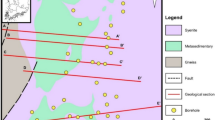Abstract
A geometallurgy study aims to link metallurgy and geology to reduce technical risk and enhance the economic performance of a mineral-processing plant. It does so by accounting for variability in a deposit to develop cash flow models with variable throughput rates. High-quality sample selection for metallurgical test work that are representative of the deposit is an essential component of a geometallurgy study, but the large multi-dimensional dataset makes sample selection a daunting task, as classifying the dataset while respecting its heterogeneity is difficult. This paper presents a streamlined approach for sample selection, utilizing statistical analysis techniques in Python. It cuts down time to select samples from around 1200 s per drillhole to about 60 s per drillhole for data classification and from 12 h to 8 h for handpicking samples from the classified dataset, translating to cost savings. The cumulative sum method and k-means clustering method are used in the methodology to elegantly classify the data and select representative samples. The effectiveness of the methodology is demonstrated by presenting data from a pre-feasibility study of a copper-iron mine in which 40 samples were selected for flotation test work.










Similar content being viewed by others
References
Lishchuk V, Koch PH, Ghorbani Y, Butcher AR (2020) Towards integrated geometallurgical approach: critical review of current practices and future trends. Miner Eng 145:106072. https://doi.org/10.1016/j.mineng.2019.106072
Dominy SC, O’Connor L, Glass HJ, Purevgerel S, **e Y (2018) Towards representative metallurgical sampling and gold recovery testwork programmes. Minerals 8(5):193. https://doi.org/10.3390/min8050193
Michaux S, O’Connor L (2020) How to set up and develop a geometallurgical program. Geol Surv Finland. https://doi.org/10.13140/RG.2.2.16170.24005
CUSUM Control Charts, NIST/SEMATECH e-Handbook of statistical methods. https://www.itl.nist.gov/div898/handbook/pmc/section3/pmc323.htm
Rajabinasab B, Asghari O (2018) Geometallurgical domaining by cluster analysis: iron ore deposit case study. Nat Resour Res 28(3):665–684. https://doi.org/10.1007/s11053-018-9411-6
Jansson NF, Allen RL, Skogsmo G, Tavakoli S (2022) Principal component analysis and K-means clustering as tools during exploration for Zn Skarn deposits and industrial carbonates, Sala area, Sweden. J Geochem Explor 233:106909. https://doi.org/10.1016/j.gexplo.2021.106909
Asuero AG, Sayago A, González AG (2006) The correlation coefficient: an overview. Crit Rev Anal Chem 36(1):41–59. https://doi.org/10.1080/10408340500526766
Cui M (2020) Introduction to the k-means clustering algorithm based on the elbow method. Geoscience Remote Sens 3(1):9–16. https://doi.org/10.23977/geors.2020.030102
Author information
Authors and Affiliations
Corresponding author
Ethics declarations
Competing Interests
The authors of this article are employees of Ausenco, an engineering consultancy that works with the world’s leading mining and mineral processing companies. Ausenco is providing consulting services for a copper mine’s pre-feasibility study. The analysis in this study was done after completing client-funded work, and the consultants got paid by Ausenco’s optimization and debottlenecking practice.
Additional information
Publisher’s Note
Springer Nature remains neutral with regard to jurisdictional claims in published maps and institutional affiliations.
Rights and permissions
Springer Nature or its licensor (e.g. a society or other partner) holds exclusive rights to this article under a publishing agreement with the author(s) or other rightsholder(s); author self-archiving of the accepted manuscript version of this article is solely governed by the terms of such publishing agreement and applicable law.
About this article
Cite this article
Siddiqui, M.U., Erwin, K., Khan, S. et al. An Efficient Sample Selection Methodology for a Geometallurgy Study Utilizing Statistical Analysis Techniques. Mining, Metallurgy & Exploration (2024). https://doi.org/10.1007/s42461-024-01011-4
Received:
Accepted:
Published:
DOI: https://doi.org/10.1007/s42461-024-01011-4




